Additions to therapy
Meditation
MeditationLearning to meditate
Benefits of meditation: you feel calmer, it reduces stress, tension and urgency, setbacks feel less important, awareness that you are not your thoughts but thoughts are what you have, it will be simpler to live in the moment, etcetera. Here are a few tips:
- Meditate without any expectations: learning to meditate is a learning process.
- Start by sitting down. Find a position that feels comfortable to you. Lying down is preferably avoided, because your body will go into sleep mode. Find a quiet location and ensure that you cannot be disturbed.
- Set a timer or use an app. Start with five minutes a day.
- Build a meditation routine: for instance, set a reminder on your phone to meditate.
- Do not try to empty your head but observe your thoughts and let them pass, like clouds in the sky.
- Increase the time you meditate a little bit each time.
Types of meditation
- Breathe slowly through your nose, from your belly. Just keep a natural rhythm, nothing special.
- Try to hold your back a little straighter at every in-breath. Imagine the crown of your head being softly pulled upwards with a string, but not forcibly.
- On every out-breath, try to relax your body further. Scan your body step by step for any tension, and let the tension go.
- When you are relaxed, focus on your breathing. Sometimes this is easy. And sometimes you get a little bit distracted.
- If you get distracted, repeat in your head ‘in... out...’ and follow your own breathing. This can help you to stay in the moment.
- Sometimes you will be dragged along a maelstrom of thoughts. As soon as you become aware of that, calmly bring your attention back to your breathing.
You count each out-breath softly in your head. You can continue to count until you loose count, and then start again at one. You can also repeatedly count to ten.
Keep your eyes open, look down, focus on a fixed point but keep your gaze soft. Breathe slowly from your belly. You can meditate like this anywhere.
Slowly scan your body from top to toe, and let any tension that you encounter flow away.
Focus your attention on the world around you. Sit calmly and listen to the sounds. Feel the chair below your bottom. Observe any scents around you. As soon as you notice any thoughts, bring your attention back to your senses.
Use an app, audio recording or YouTube video and simply follow the instructions. App examples include VGZ Mindfulness, Mindfulness App or Insight Timer.
Meditation exercises
This is one of the simplest meditation techniques.
- Find a comfortable spot. Sit down with your back straight. It is important that you do not lie down or slump, which may cause you to fall asleep. Be alert and make sure that you are not disturbed by others or your phone.
- Relax your hands and rest them in your lap.
- Close your eyes.
- Calmly and fully breathe in and out. Let your breathing find its own, calm rhythm. This will often be somewhat slower than normal.
- Concentrate on your breathing and on nothing else.
- If a thought forms, recognise the thought, let it pass and bring your attention back to your breathing.
Extension with focus on the heart
- Focus your attention on your heart, in the centre of your chest.
- Keep your attention focussed on the area of your heart and, while breathing, imagine your breath flowing through your heart.
- While doing so, focus your attention on a positive feeling. This can be feelings of love for someone, or feelings of appreciation for someone or something in your life.
This relaxation exercise is suitable for anyone who builds up noticeable tension in their body. Sit on a chair in a relaxed position.
- Let your arms hang freely. Clench your hands into fists and tense all muscles in your lower and upper arm. Tense your biceps as hard as possible. Then, relax them. Repeat if necessary.
- Now, tense the muscles in your face. Scrunch up your eyes, mouth, nose and jaws for a few seconds, then relax your facial muscles.
- Tense your shoulder and abdominal muscles by moving your shoulder blades toward each other and by tightening your abdomen. Push your chest out.
- Lift your shoulders and tense them firmly, then lower and relax them.
- Sit or lie down, close your eyes, breathe in and out a few times and feel the tension disappear.
- Imagine an air bubble forming around you and feel how you slowly start to float.
- You can navigate the air bubble yourself. You choose to slowly fly out of the room and move upward. You can choose wherever you want to go. What does your heart tell you?
- Gently land in the location where you would like to be the most of all. For instance a quiet beach, a beautiful flower garden, in the middle of an endless meadow, whatever relaxes you the most.
- Stay there as long as you like. Try to make the sensation feel as real as possible. Smell the flowers, feel the wind, hear the birds. When you are ready, step back into the air bubble and let yourself fly back to reality.
- Sit or lie down, close your eyes, breathe in and out a few times and feel the tension disappear.
- Imagine an air bubble forming around you and feel how you slowly start to float.
- You can navigate the air bubble yourself. You choose to slowly fly out of the room and move upward. You can choose wherever you want to go. What does your heart tell you?
- Gently land in the location where you would like to be the most of all. For instance a quiet beach, a beautiful flower garden, in the middle of an endless meadow, whatever relaxes you the most.
- Stay there as long as you like. Try to make the sensation feel as real as possible. Smell the flowers, feel the wind, hear the birds. When you are ready, step back into the air bubble and let yourself fly back to reality.
This exercise to relax physically, and therefore also mentally. It can help you go to sleep and if you do this exercise every day for a few weeks, it will gradually become easier to relax. You do the exercise while lying on your bed or on a soft rug. You will tense and relax alternate muscle groups and will be continuously aware of how that feels.
Read these instructions before you start:
- Lie down on your back. Place your arms loosely next to you and your legs slightly apart.
- Start at your left leg. Lift it slightly from the floor and tense the muscles, including the muscles in your feet. Hold it for four slow counts. Carefully place your leg back on the floor on an out-breath, relax all muscles while repeating the word ‘relax’ in your head. Feel the difference. Repeat this once more.
- Do the same with your right leg.
- Now for your left arm: lift it slightly, tense all muscles, clench your hand into a fist. Hold for four counts then carefully place your arm back on the floor on an out-breath, relax all muscles while repeating the word ‘relax’ in your head. Feel the difference in muscle tension with before. Repeat this once more.
- Do the same with your right arm.
- Now tighten your abdominal and buttock muscles firmly. Hold as tightly as you can for four slow counts. Then let the tension go on an out-breath and repeat the ‘relax’ to yourself. Do this a second time.
- Now tense your shoulders by lifting them. Hold for four counts and relax again on an out-breath while saying “relax” to yourself. Do this once more.
- Lift your head slightly and tighten all muscles in your face. Clench your teeth, frown your eyebrows and scrunch up your face. Hold for four counts then carefully put your head back on the floor, relax your face on an out-breath and repeat to yourself ‘relax’. Feel the difference and repeat after a short while.
- Remain lying down for a short while and be aware of your body as it lies on the bed or rug.
Body scan
Body scanThe objective of this exercise is to feel the difference between physical tension and relaxation. We often forget that we cause our muscle tension ourselves. We then look for the solution outside of ourselves, for instance by having a massage. This can offer temporarily relief, but the tension often comes back quickly once the ‘forced relaxation’ is forgotten. It is therefore important to feel how you cause the tension, including that of your muscles, yourself. By consciously doing what you did before unconsciously, that is tightening your muscles, you will become aware of this energy. You can then focus this energy and let it flow for something that you want to achieve, rather than having it in a blockade in yourself. Ensure that you can do this exercise undisturbed.
- Take a comfortable position, with your back as straight as possible. Sit comfortably.
- Focus your attention on your breathing. Slowly breathe in for five counts and out for eight counts.
- Concentrate on your feelings and do not let any noise, sounds or thoughts distract you, just continue the exercise.
Focus your attention:
Focus your attention on your ... (e.g. lower right arm and hand)
Tense:
- Now tighten the muscles in your ... (e.g. lower right arm and hand)
- Feel the tension in your ... (e.g. lower right arm and hand)
- Briefly hold this tension
Relax:
- Relax again when exhaling. Tell yourself ‘relax’.
- Concentrate on the difference between tightening and relaxation.
- The muscles of ... (e.g. the lower right arm and hand) are now fully relaxed
Programme:
- Right hand, lower right arm: Clench your right hand into a fist. At the same time, tighten your lower right arm.
- Right upper arm: Flex your right arm with the hand open and facing upwards.
- Left hand, lower left arm: Clench your left hand into a fist. At the same time, tighten your lower left arm.
- Upper left arm: Flex your left arm with the hand open and facing upwards.
- Forehead: Crease your forehead by raising your eyebrows.
- Eyes: Close your eyes tightly.
- Nose: tighten your nose muscles by scrunching your nose.
- Mouth: tighten your lip muscles by puckering your mouth.
- Jaw muscles: Tighten your jaw muscles by lightly clenching your teeth.
- Neck: Tighten the neck muscles by lifting your shoulders to your ears.
- Shoulders: Tighten the shoulder muscles. Pull the shoulders back.
- Back: Tighten the back muscles so that your back is somewhat hollow.
- Abdomen: Tighten the abdominal muscles.
- Buttocks: Tighten the buttocks by clenching them.
- Upper right leg: Tighten the upper leg muscles of your right leg. To do this, press your right foot into the floor, using the entire sole.
- Lower right leg: Tighten the lower leg muscles of your right leg by pulling up your forefoot. Your heel must remain on the floor.
- Right foot: Tighten the muscles of your right foot. Curl your toes as if you want to pick something up.
- Upper left leg: Tighten the upper leg muscles of your left leg. To do this, press your left foot into the floor, using the entire sole.
- Lower left leg: Tighten the lower leg muscles of your left leg by pulling up your forefoot. Your heel must remain on the floor.
- Left foot: Tighten the muscles of your left foot. Curl your toes as if you want to pick something up.
Conclusion:
- Sense the relaxation throughout your body.
- Wander through your body and sense the relaxation.
- Focus your attention on your breathing and feel yourself relax further on each out-breath.
- Now count to five. On three, move your hands and toes and on five, open your eyes and take a few deep breaths.
In this relaxation exercise you learn to experience every sensation in your body without any judgement. Lie down on the floor, close your eyes and relax.
- Guide your attention to your body. Feel how your body presses into the floor. Slowly breathe in and out and feel yourself sink further into the floor at each out-breath. Take your time.
- When you feel nice and relaxed, guide your attention to your left little toe. Feel how your attention flows to your toe. Steer your attention slowly to your other toes, your foot, your calf and the rest of your leg.
- Then move your attention to your other foot and repeat this step. Next, move your attention higher up and slowly ‘scan’ your body. Feel how the your attention moves through your body, and feel how you relax more deeply every time you exhale. Every time that you feel any tension somewhere, hold your attention there, relax this area, then continue.
This combination of two exercises provides a deeper sense of relaxation and additionally, it can also result in a fundamental change of your sense of ‘self’. You may begin to feel a deep inner sense of freedom, of lightness, release and stability.
The exercise consists of two parts: first the body scan, followed by the disidentification.
Body scan
- Sit or lie down, close your eyes and focus your attention on your breathing.
- Become aware of every time you inhale and exhale. Let your breathing take its course and do not try to control it.
- Observe how the air slowly enters your nose, fills your lungs and leaves your body again.
- When, after breathing in and out a few times, you feel nice and comfortable we start the body scan.
- Focus your attention on your forehead. Try to feel the skin and be aware of any tingling and tension and relax by breathing in and out once.
- If you do not feel anything at that time, that is fine too. Allow yourself to feel that you do not feel anything.
- Do the same for the nose, ears, eyes, eyebrows, jaw, mouth, lips and skin of your face and the back of your head. Feel your mouth and jaw relax and feel your eyes sink into their sockets.
- Then, focus your attention on your neck, collarbones, shoulders, left and right upper arms, elbow, lower arm, hand and fingers. Scan these areas on the left and right sides one by one.
- Every time your thoughts wander, gently return your attention to the area you were.
- Again, try to feel and experience all sensations.
- If you can, try to relax the area that your attention is focussed on every time you exhale.
- Focus your attention on your chest, diaphragm, upper back, lower back, spine.
- Feel your breathing and potentially, your posture, change by relaxing. Does your body feel differently?
- Continue the body scan and focus your attention on your pelvis, buttocks and on both upper legs, knees, lower legs, ankles, feet and toes. Take your time.
- Notice the difference between the different areas. Feel the tingling in your body, feel your muscles getting increasingly relaxed and notice which areas relax less easily.
- Let your body feel heavy all over. Your are now completely relaxed.
- When you have refreshed and relaxed your whole body, return your attention once more to an area in your body that felt a bit tense. Give your full attention to that area and try to relax it. Do you feel the difference? Do certain thoughts or emotions get released? Notice them and let them go.
- Finally, tighten all muscles twice for three seconds and release on a breath.
Extension with disidentification
Preparation:
Remain seated in a comfortable and relaxed position and keep your eyes closed. Feel your feet firmly on the ground and feel how you are being supported by the chair. Breathe in a rhythm that you feel comfortable with.
While you are sitting like this:
- Focus your attention on your body for a while.
- Then say with full conviction: “I have a body and I am more than my body.”
- Let the meaning of these words sink deep into your consciousness for a while.
- Become aware of your feelings.
- Then say with full conviction: “I have feelings and I am more than my feelings.”
- Let the meaning of these words sink deep into your consciousness for a while.
- Become aware of your thoughts.
- Then say with full conviction: “I have thoughts and I am more than my thoughts.”
- Let the meaning of these words sink deep into your consciousness for a while.
- Then affirm to yourself, with great conviction: ‘I am a centre of pure self-consciousness, silence and will.’
- And then: ‘My centre is a reflection of my Higher Self, an endless Source of qualities.’
- And then: ‘I open my centre to the influx of the quality Trust.’
- Then, let the quality Trust flow into your consciousness for a while and when you feel it is enough, slowly come back, moving your attention from the inside to the outside. You can vary this exercise by choosing another quality. A quality you fell you need at the moment. For instance, mildness, love, beauty, creativity, strength, or softness, intuition, etcetera.
Mindfulness
MindfulnessThis exercise has a threefold effect. It ensures relaxation, a here-and-now experience and also strengthens the will.
- Find a comfortable place for this exercise too.
- Slowly breathe in and out a few times in a rhythm that feels comfortable to you.
- Next, focus your attention on five things that you see in the space around you and point them out loud to yourself. Slowly breathe in and out once between every item you name.
- Then focus your attention on five things you hear and slowly breathe in and out once between every item you name.
- Next, focus your attention on five things you sense. This is about sensory feelings and not emotions such as sadness or happiness, but for instance the contact of the sole of your foot with the ground. Again, slowly breathe in and out once between every item you name.
- Next, point out four things that you see. And four things that you hear and sense. Slowly breathe in and out once between every item you name.
- Do the same thing again, but then with three things. Then with two things, and finally, one thing.
When your attention is distracted, recognise the thought, let it pass, steer your attention back to the exercise and continue where you left off.
Apps
AppsHere, you can find apps you can use during and after your hospital stay:
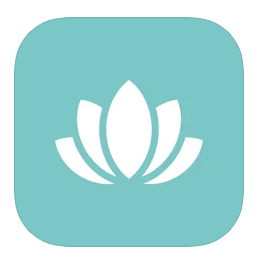
This app offers you a choice from different themes: mindfulness, yoga, breathing and relaxation. You can do the associated exercises. There are advanced as well as beginner exercises. You can also choose from a number of stand-alone exercises. The app can be downloaded for free (so you can try it out without any obligation).
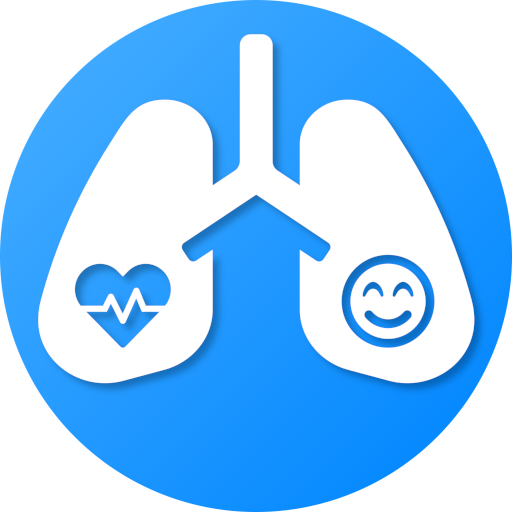
This app can be used for breathing exercises. This can help to calm down, for instance when in a state of anxiety. The app can be downloaded for free.
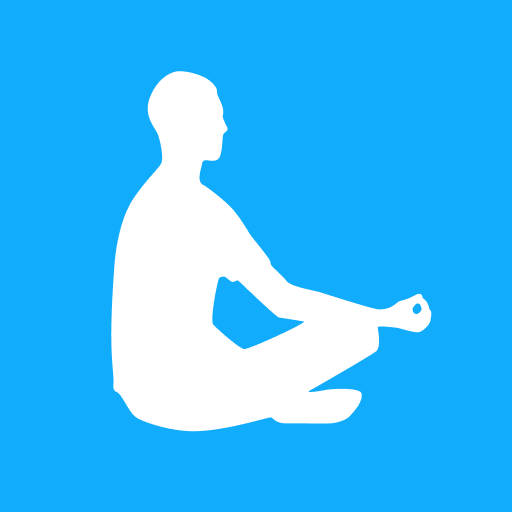
This app helps you to be more in the here and now. It contains exercises (guided and silent meditations) from three to 30 minutes. The app can be downloaded for free.
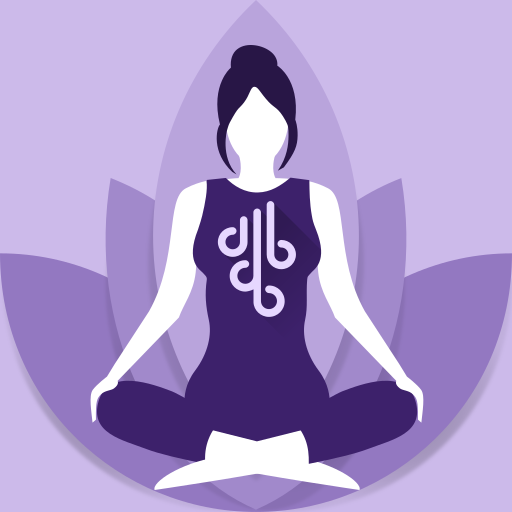
This app offers breathing exercises. It has eight breathing patterns and offers the possibility to create your own pattern. It also has a ‘replace cigarette’ function to help you quit smoking.
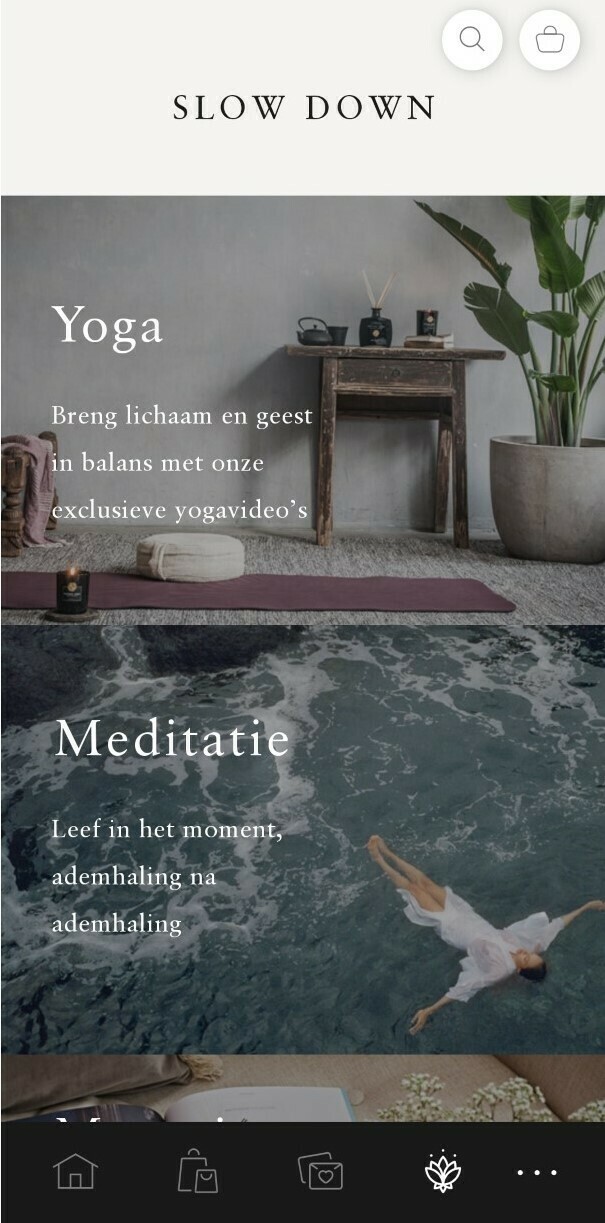
This app allows you to do a number of yoga and meditation exercises. You can access them by clicking on the fourth icon at the bottom. You can then choose from several exercises. You can download the app for free.
Walking routes
Walking routesThis park is reasonably close to the hospital. You can do short walks in it. The image below shows how it can be reached. More information can be found through this link.
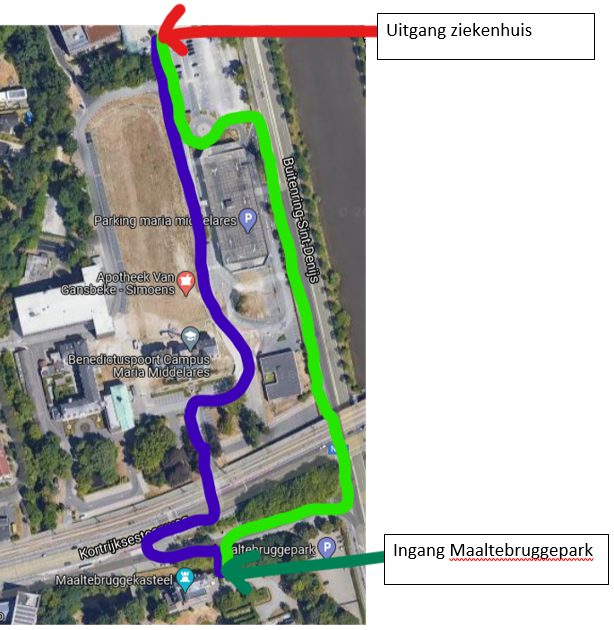
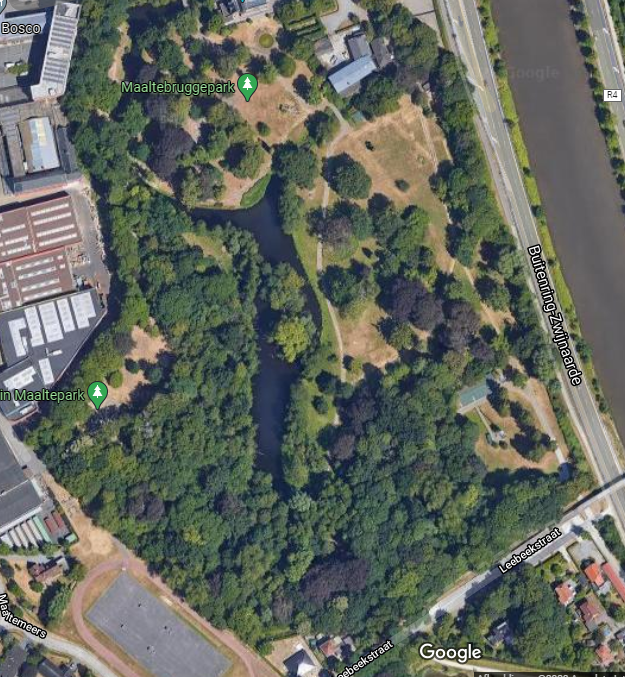
- Starting point: sports hall Ghent-Bruges, Driebeekstraat 22 (red mark on the map)
- The walk is 6 km (the red dotted line that can be seen when you zoom in)
- Advantages: Geboortebos forest, varied scenery (Schelde River dike, forest, meadows, etcetera.)
- Disadvantages: near the motorway: noisy. The view is spoilt in some areas by litter, lorry park, etcetera.
- More information
- Starting point: sports hall Bourgoyen, Driepikkelstraat 30, Mariakerke
- Walk: Bourgoyen Way = 5.5 km (blue dotted line) and the Meerskant Way = 4.4 km (red dotted line)
- Advantages: beautiful scenery, varied flora and fauna
- Disadvantage: some areas are difficult to access in rainy conditions
- More information
- Starting point: Drongenplein, Drongen
- The walk is 6 km
- Advantages: beautiful path along the river Leie, varied scenery
- Disadvantages: the first part is difficult to access in rainy conditions, the first part of the walk is along a busy road
- More information
- Starting point: Dendermondsesteenweg 420, Destelbergen (= library)
- Walking routes: Bergenmeersen Way = 7 km and the Damvallei Way = 9 km
- Advantages: beautiful start of the walk around two lakes and varied scenery (fauna/flora)
- Disadvantages: busy road crosses the paths and signage is not that good
- More information
- Starting point: Merendree Church
- Walks: the walk is 7 km.
- Advantages: good contact with nature as you walk surrounded by fields, you can experience true quiet
- Disadvantages: signage and distance from Mirabello
- More information
- Starting point: Poelstraat 184, Merelbeke
- Area for walking = 22 ha
- Advantages: good contact with nature. You can experience the quiet; beautiful in spring and in summery weather (nature is in full blossom)
- Disadvantages: not a very large area, difficult terrain during bad and/or wet weather
- More information
- Starting point: Poelstraat 184, Merelbeke
- Walking area = 22 ha
- Advantages: good contact with nature. You can experience the quiet; beautiful in spring and in summery weather (nature is in full blossom)
- Disadvantages: not a very large area, difficult terrain during bad and/or wet weather
- More information
- Starting point: Meersstraat Sint-Martens Latem
- Walking routes: Red walk = 4 km and the Blue walk: = 3.7 km
- The pictured walking route is 7.8 km.
- Advantages: beautiful, varied scenery (river Leie, surrounded by fields, quiet streets), you can experience the quiet, no noise pollution
- Disadvantages: signage not that good and difficult terrain at some points (specifically on stretches through the fields)
- More information
- Starting point: Zuiderlaan, Ghent
- Area for walking = 100 ha
- Advantages: beautiful paths and area (observation post), offers possibilities for relaxing activities (playground,
beach, beach sports, picnic, etcetera.) - Disadvantages: may be very crowded in good weather
- More information
- Starting point: Droogte, Evergem
- Walk = 6.1 km
- Advantages: beautiful area, scenery, varied nature, but also features historical sights (Wippelgem Castle)
- Disadvantages: some stretches are on busy roads
- More information
- Starting point: Puyenbrug, Wachtebeke
- Walk: red walk = 5.3 km; longer walks can be found on the website below.
- Advantages: beautiful wooded area, offers many opportunities for relaxing activities
- Disadvantages: may be very crowded in high season, signage not clearly visible
- More information
Health and exercise
Health and exerciseTips to integrate exercise into your daily life
- Take the stairs in place of the lift.
- Go to the bakery and do your shopping on foot or by bicycle.
- Park your car at a distance and walk the rest.
- If you have a sedentary job:
- Regularly tighten and relax your abdominal muscles when seated
- Regularly stretch your legs
- Put documents somewhere different so that you need to get up, etcetera.
The importance of sports and exercise
- Increase in endorphins due to sports and exercise.
- Endorphins are the body’s own substance that cause a sense of euphoria (happy hormones) and that are released when smoking, eating sweets, etcetera, but also when exercising and doing sports.
- Everybody needs endorphins!
- Advantage of sports = reducing smoking behaviours, alcohol consumption and the urge to eat sweets because the body already has enough endorphins.
- Too many (stress) stimuli may negatively affect sleeping patterns.
- Sports and exercise helps channel any stimuli and clear your head.
- You feel more physically tired and this encourages good sleep.
- Exception: highly intense sports activity before sleep has the effect of increasing adrenaline levels, making it difficult to go to sleep.
- Group sports (both as part of a club or non-organised) help to make social contacts.
- Individual sports (e.g. fitness training) also allow you to make contact with others who are exercising at the same time.
- Disadvantage of group sports: if somebody else quits, people tend to stop themselves more easily too.
- Golden tips!
- Exercise of your own free will!
- Exercise too when things are difficult, you will be happy afterwards!
- Find a sport that suits you and that you enjoy doing, that’s how you will be able to keep it up!
- Sports help to clear your head.
- The focus is solely on the movement, technique, exertion, etcetera.
- The increase in fitness results in reduced fatigue and therefore, an increase in stress tolerance.
- Sports and exercise may help against minor complaints such as colds.
- The risk of cardiovascular disease, diabetes, etcetera is reduced by sports and exercise.
- Sports can reduce the risk of recurrence of certain cancers (e.g. breast cancer).
- Doing moderate-intensity training at regular times (three times a week) ensures an increase in fitness levels
- It is recommended to exercise 30 minutes every day (this boosts your metabolism every time, making it more efficient).
- It is not recommended to do two hours or more of sports once a week => metabolism is boosted once => risk of overload and injuries increases. Building up fitness is usually slower than building up strength and muscle mass, but once fitness has been built up, the basic fitness level is not easily lost. This is the other way round for strength and muscle volume.
- Due to the increase in endorphins.
- Due to the increase in social contact.
- Due to the increase in stress tolerance.
- Due to physical changes in the positive sense: more muscle mass, less fat, thinner figure, weight loss.
- Due to the increase in coordination.
- Due to the increase in fitness level.
Something wrong or unclear on this page? Report it.


